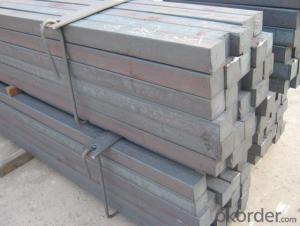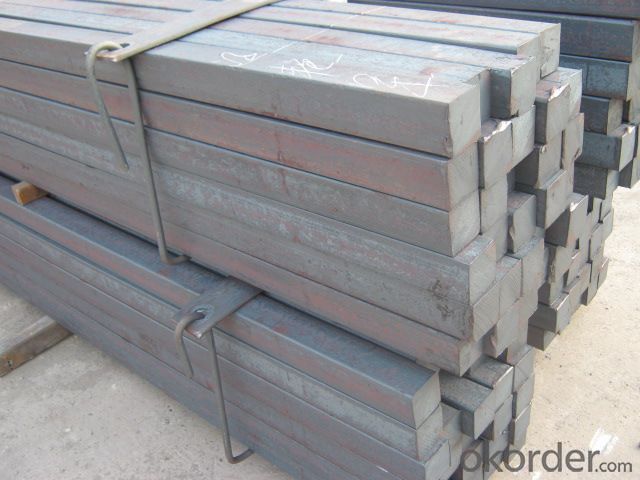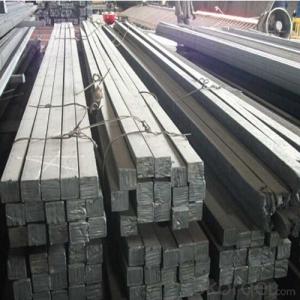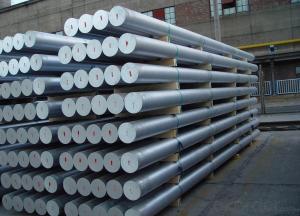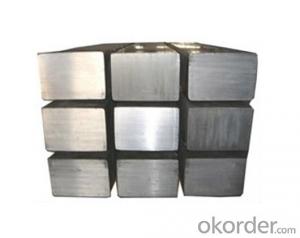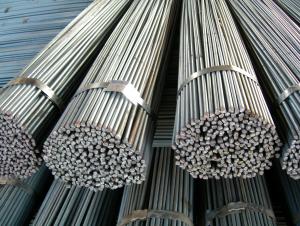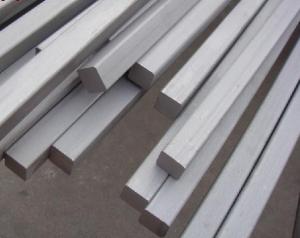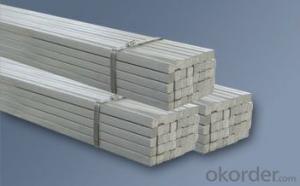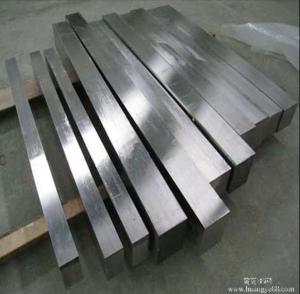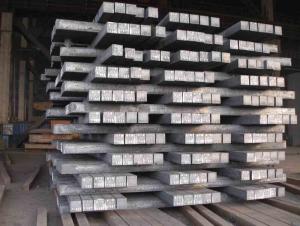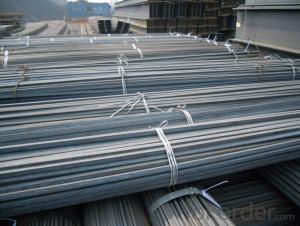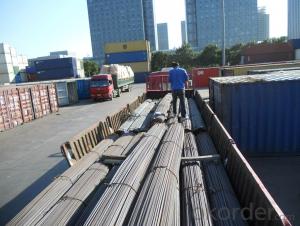Steel Square Bar 5mm-100mm Q195 or Q235 top quality
- Loading Port:
- China main port
- Payment Terms:
- TT OR LC
- Min Order Qty:
- 50 m.t.
- Supply Capability:
- 10000 m.t./month
OKorder Service Pledge
OKorder Financial Service
You Might Also Like
Steel Square Bar High Quality 5mm-100mm Q195 or Q235
Product Description:
OKorder is offering High Quality Square Bar 5mm-100mm Q195 or Q235 at great prices with worldwide shipping. Our supplier is a world-class manufacturer of steel, with our products utilized the world over. OKorder annually supplies products to European, North American and Asian markets. We provide quotations within 24 hours of receiving an inquiry and guarantee competitive prices.
Product Applications:
1) Suitable for making various strong cutting tool abrasion resistance, impact resistance.
2) Used to produce all kinds of high hard and super hard saw blade, drill, tap, broach, gear hob and various kinds of milling cutter.
3) Used for advanced punching die, screw die, and the toughness and complicated shape of the punch, etc.
4) Is used for cold forging die and drawing mode, etc.
5) Recommended watchcase factory, screw factory and other cold stamping products industry use.
Product Advantages:
OKorder's High Quality Square Bar 5mm-100mm Q195 or Q235 are durable, strong, and resist corrosion.
Main Product Features:
· Premium quality
· Prompt delivery & seaworthy packing (30 days after receiving deposit)
· Corrosion resistance
· Can be recycled and reused
· Mill test certification
· Professional Service
· Competitive pricing
Product Specifications:
Standard: GB,
-Grade: Q195 or equivalent.
-Chemical Composition:
Standard | Grade | Element (%) | ||||
GB | Q195 | C | Mn | S | P | Si |
0.06~0.12 | 0.25~0.50 | ≤0.050 | ≤0.045 | ≤0.30 | ||
Measures of HR Square Bar (small measures):
-Length of a side and Theoretical weight of Square Bar.
Length of a side(mm) | Theoretical weight(kg/m) | Length of a side(mm) | Theoretical weight(kg/m) |
7 | 0.385 | 22 | 3.80 |
8 | 0.502 | 24 | 4.52 |
9 | 0.636 | 25 | 4.91 |
10 | 0.785 | 26 | 5.30 |
11 | 0.950 | 28 | 6.15 |
12 | 1.13 | 30 | 7.06 |
13 | 1.33 | 32 | 8.04 |
14 | 1.54 | 34 | 9.07 |
15 | 1.77 | 36 | 10.17 |
16 | 2.01 | 38 | 11.24 |
17 | 2.27 | 40 | 12.56 |
18 | 2.54 | 42 | 13.85 |
19 | 2.82 | 45 | 15.90 |
20 | 3.14 | 48 | 18.09 |
21 | 3.46 | 50 | 19.63 |
Notes:
1, The theoretical weights in the list, base on the density of 7.85 g/cm3.
2, Formula for theoretical weight of Square bar: (length of a side)2 * 0.00785
3, The numbers with *mean that they are not regular or we don’t offer them.
-Regular length of Square Bar:
Steel | Length of a side (mm) | Length of steel (m) |
Normal steel | < 25 | 4~10 |
> 25 | 3~9 | |
Steel of high quality | All measure | 2~6 |
Tool steel >75 | 1~6 |
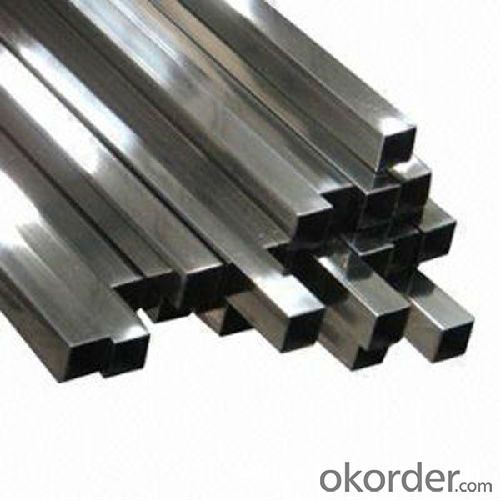
- Q: Can a steel square be used for cabinet hardware installation?
- Cabinet hardware installation can benefit from the use of a steel square. Known as a framing square or carpenter's square, this versatile tool serves multiple purposes in woodworking, including cabinet installation. It guarantees precise and square cuts, measures and marks lines, and checks for level and plumb. With the help of a steel square, cabinet hardware can be aligned and spaced correctly. Furthermore, it aids in measuring and marking hole locations for drilling. Ultimately, a steel square proves to be an invaluable tool in achieving accurate and professional results during cabinet hardware installation.
- Q: Can a steel square be used for stair-building projects?
- Certainly! A steel square is capable of being utilized in stair-building endeavors. Commonly known as a framing square or carpenter's square, this versatile tool is frequently employed in woodworking and construction undertakings. With its 90-degree angle, it is ideal for measuring and delineating right angles, a crucial element in stair construction. By means of a steel square, one can assess the precision of cuts and angles, guarantee the proper positioning of stringers and treads, and confirm the levelness and stability of the stair framework. This enduring and dependable instrument is applicable for both residential and commercial stair-building ventures.
- Q: How do you use a steel square to determine rafter lengths?
- To use a steel square to determine rafter lengths, you first need to understand the different markings and measurements on the steel square. There are two main parts of a steel square: the body and the tongue. The body of the steel square is the longer side, usually about 24 inches in length. It has multiple markings and numbers along its edge. The tongue is the shorter side, usually about 16 inches in length, and it is perpendicular to the body. To determine rafter lengths, follow these steps: 1. Start by placing the steel square on the rafter stock with the body against the edge of the board and the tongue extending over the top surface. 2. Align the tongue with the desired pitch or roof slope angle. The pitch is typically measured in inches per foot. For example, a 6/12 pitch means a rise of 6 inches for every 12 inches of run. 3. Once the tongue is aligned with the desired pitch, mark the point where the body intersects the edge of the rafter stock. This point represents the plumb cut or the top of the rafter. 4. Next, slide the steel square along the edge of the rafter stock until the desired rafter length is achieved. The rafter length is measured from the plumb cut to the desired run, which is the horizontal distance the rafter will span. 5. Mark the point where the body intersects the edge of the rafter stock. This point represents the bird's mouth or the bottom of the rafter, where it will sit on the wall plate. 6. Finally, connect the two marked points with a straight line to determine the plumb cut and bird's mouth on the rafter. By using the steel square in this manner, you can accurately determine the lengths and cuts for rafters based on the desired pitch and run of the roof. This method ensures that the rafters will fit properly and provide the necessary structural support for the roof.
- Q: Can a steel square be used for gate post layout and installation?
- Yes, a steel square can be used for gate post layout and installation.
- Q: How do you use a steel square to measure and mark 219.375-degree angles?
- To use a steel square to measure and mark 219.375-degree angles, you would first need to locate the 0-degree mark on the steel square. This mark is typically found on the inside edge of the long side of the square. Next, align the long side of the square with the reference line or edge of the material you want to measure and mark. Ensure that the 0-degree mark is perfectly aligned with the starting point of the angle. Now, keeping the square fixed in position, rotate the material until the desired angle measurement of 219.375 degrees is reached. You can use a protractor or other angle measuring tools to assist you in accurately determining the angle. Once the angle is set, carefully mark the endpoint of the angle on the material using a pencil or a scribe. You can also use the edge of the steel square to create straight lines perpendicular to the angle as needed. It is important to note that steel squares typically have markings only for common angles like 45, 90, and 180 degrees. Therefore, measuring and marking angles that are not explicitly marked on the square, such as 219.375 degrees, may require additional tools or calculations.
- Q: How do you use a steel square to measure rafter lengths?
- Before you can measure rafter lengths using a steel square, it is important to familiarize yourself with the markings and measurements on the square itself. The square consists of a blade and a tongue, with the blade typically containing different scales and numbers, while the tongue is wider and shorter. When measuring rafter lengths, the blade of the steel square is primarily used. Begin by placing the square on the edge of the rafter board, making sure that the tongue is facing towards the end of the board. Align the end of the board with the zero mark on the blade. Next, identify the scale on the blade that corresponds to the pitch or slope of the roof. These scales are usually denoted in inches and degrees and are essential in determining the length of the rafter. For instance, if the roof pitch is 6/12, utilize the scale marked "6" on the blade. While keeping the tongue pressed against the edge, slide the square along the rafter board. As you move the square, pay close attention to the measurements on the blade. The point at which the desired measurement on the blade aligns with the edge of the board indicates the length of the rafter. To mark this point on the rafter board, use a pencil or a marking tool. Repeat these steps for each rafter, ensuring that you consistently use the same scale on the blade for accurate measurements. Aside from measuring rafter lengths, a steel square possesses various other functions, such as marking angles, making cuts, or checking for squareness. It is a versatile tool that greatly aids in numerous construction and woodworking projects.
- Q: Can a steel square be used for measuring the depth of a foundation?
- A foundation's depth can be measured using a steel square. The steel square, also referred to as a framing square or carpenter's square, is a versatile tool utilized in construction and carpentry for various measurement and layout tasks. It consists of a straight, long edge with a handle perpendicular to it, creating a right angle. To measure a foundation's depth using a steel square, position the square vertically against the foundation's side, ensuring that the long edge aligns with the foundation surface. By examining the markings or measurements on the square, you can determine the foundation's depth. Nevertheless, it is important to note that relying solely on a steel square may not provide precise measurements of the foundation's depth. While it can offer a rough estimate, for accurate results, specialized tools such as a tape measure or a laser level should be used in conjunction with the steel square. Additionally, it is advisable to consult a professional engineer or contractor for more accurate measurements and to ensure the foundation is properly evaluated for construction or renovation purposes.
- Q: How do you use a steel square to ensure the correct angle for a mitered corner joint?
- To achieve the correct angle for a mitered corner joint, one can employ a steel square and follow these guidelines: 1. Begin by preparing the two material pieces intended for the mitered corner. Ensure that both pieces are cut at the standard 45-degree angle for a miter joint. 2. Position the steel square at the corner where the two material pieces will be joined. Confirm that one side of the square aligns with the edge of one piece, while the other side aligns with the edge of the second piece. 3. Assess the square's alignment against both material pieces. The square's corner should seamlessly fit into the joint's corner. If this is not the case, it indicates an incorrect angle of the cut. 4. In the event of misalignment, adjust the angle of one or both pieces until the square fits flawlessly into the joint. This may entail trimming or sanding the edges until they match appropriately. 5. Once the square fits into the joint without any gaps or overlaps, proceed to join the pieces together using your preferred method, such as nails, screws, or glue. By utilizing a steel square to verify the angle of the mitered corner joint, one can guarantee accuracy and a seamless fit between the material pieces. This is vital for achieving a professional and visually pleasing outcome in carpentry or woodworking projects.
- Q: What are some common uses of a steel square in construction?
- A steel square, also known as a framing square or carpenter's square, is a versatile and essential tool in construction. It is primarily used for measuring, marking, and verifying right angles, ensuring accurate and precise cuts and joints. Here are some common uses of a steel square in construction: 1. Layout and marking: A steel square is used to lay out and mark straight lines, angles, and perpendicular lines on various construction materials such as wood, metal, and concrete. It helps ensure precise measurements and angles for accurate cutting, drilling, and assembly. 2. Checking squareness: Steel squares are used to check if corners and joints are perfectly square, ensuring that structures, frames, and components are aligned properly. This is crucial for maintaining structural integrity and preventing issues like sagging or misalignments. 3. Cutting and shaping: The square's straight edges and angles are used as guides for cutting and shaping materials. It helps carpenters and masons make precise cuts, whether it's cutting rafters, framing studs, or marking and cutting notches and angles on different construction elements. 4. Roofing and stair construction: Steel squares are widely used in roofing and stair construction. They help layout and cut roof rafters, determine the angle and pitch of a roof, and ensure that staircases have accurate and consistent riser and tread dimensions. 5. Foundation and concrete work: Steel squares are used to ensure the right angles, levelness, and alignment of foundation footings, concrete walls, and slabs. It helps builders maintain the structural integrity of the foundation, ensuring stability and preventing future issues. 6. Checking for plumb and level: A steel square is used to check if walls, posts, and columns are perfectly vertical (plumb) or horizontal (level). This is done by placing the square against the surface and verifying if the bubble in a level or plumb-bob aligns with the reference lines on the square. 7. Laying out stairs and handrails: Steel squares are useful for laying out and marking the rise and run dimensions of stairs. They help ensure consistency and accuracy in the construction of steps and handrails, providing safety and comfort for users. Overall, a steel square is an indispensable tool in construction due to its versatility and precision. It helps carpenters, masons, and other construction professionals ensure accurate measurements, angles, and alignments, resulting in well-built and structurally sound projects.
- Q: How do you use a steel square to check for level and plumb?
- To use a steel square to check for level, you can place one side of the square against a surface and observe if the bubble in a level is centered within the vial. If it is, the surface is level. For checking plumb, you can hold the square against a vertical surface and ensure that the edge of the square is parallel to the surface. If it is, the surface is plumb.
Send your message to us
Steel Square Bar 5mm-100mm Q195 or Q235 top quality
- Loading Port:
- China main port
- Payment Terms:
- TT OR LC
- Min Order Qty:
- 50 m.t.
- Supply Capability:
- 10000 m.t./month
OKorder Service Pledge
OKorder Financial Service
Similar products
Hot products
Hot Searches
Related keywords
